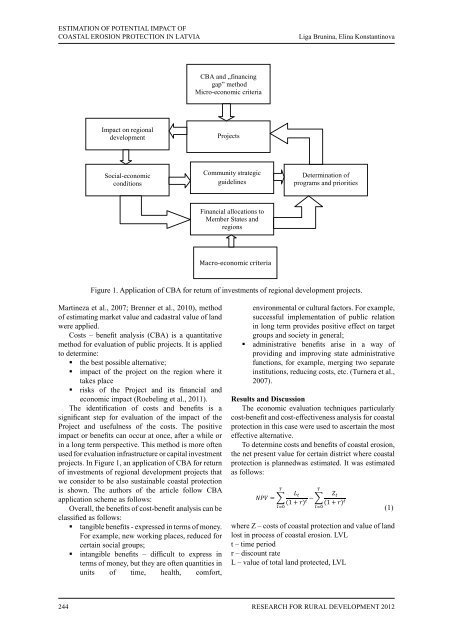RESEARCH FOR
RESEARCH FOR
RESEARCH FOR
Create successful ePaper yourself
Turn your PDF publications into a flip-book with our unique Google optimized e-Paper software.
ESTIMATION OF POTENTIAL IMPACT OF<br />
COASTAL EROSION PROTECTION IN LATVIA<br />
Impact on regional<br />
development<br />
Social-economic<br />
conditions<br />
Martineza et al., 2007; Brenner et al., 2010), method<br />
of estimating market value and cadastral value of land<br />
were applied.<br />
Costs – benefit analysis (CBA) is a quantitative<br />
method for evaluation of public projects. It is applied<br />
to determine:<br />
� the best possible alternative;<br />
� impact of the project on the region where it<br />
takes place<br />
� risks of the Project and its financial and<br />
economic impact (Roebeling et al., 2011).<br />
The identification of costs and benefits is a<br />
significant step for evaluation of the impact of the<br />
Project and usefulness of the costs. The positive<br />
impact or benefits can occur at once, after a while or<br />
in a long term perspective. This method is more often<br />
used for evaluation infrastructure or capital investment<br />
projects. In Figure 1, an application of CBA for return<br />
of investments of regional development projects that<br />
we consider to be also sustainable coastal protection<br />
is shown. The authors of the article follow CBA<br />
application scheme as follows:<br />
Overall, the benefits of cost-benefit analysis can be<br />
classified as follows:<br />
� tangible benefits - expressed in terms of money.<br />
For example, new working places, reduced for<br />
certain social groups;<br />
� intangible benefits – difficult to express in<br />
terms of money, but they are often quantities in<br />
units of time, health, comfort,<br />
CBA and „financing<br />
gap” method<br />
Micro-economic criteria<br />
Projects<br />
Community strategic<br />
guidelines<br />
Financial allocations to<br />
Member States and<br />
regions<br />
Macro-economic criteria<br />
environmental or cultural factors. For example,<br />
successful implementation of public relation<br />
in long term provides positive effect on target<br />
groups and society in general;<br />
� administrative benefits arise in a way of<br />
providing and improving state administrative<br />
functions, for example, merging two separate<br />
institutions, reducing costs, etc. (Turnera et al.,<br />
2007).<br />
results and discussion<br />
The economic evaluation techniques particularly<br />
cost-benefit and cost-effectiveness analysis for coastal<br />
protection in this case were used to ascertain the most<br />
effective alternative.<br />
To determine costs and benefits of coastal erosion,<br />
the net present value for certain district where coastal<br />
protection is plannedwas estimated. It was estimated<br />
as follows:<br />
244 ReseaRch foR RuRal Development 2012<br />
∑<br />
Liga Brunina, Elina Konstantinova<br />
Determination of<br />
programs and priorities<br />
Figure 1. Application of CBA for return of investments of regional development projects.<br />
∑<br />
(1)<br />
where Z – costs of coastal protection and value of land<br />
lost in process of coastal erosion. LVL<br />
t – time period<br />
r – discount rate<br />
L – value of total land protected, LVL


